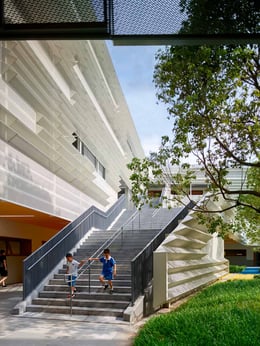Login
Registered users
Prioritizing outdoor spaces and contact with nature

The Nanshan Foreign Language School in Shenzhen takes an unconventional approach to education and development. Designed by Studio Link-Arc, this combined elementary and middle school is located in a densely populated area and surrounded by residential and commercial towers. The project contrasts with its dense urban setting with a linear design with large open and semi-open spaces intended to encourage interaction.

Intentionally breaking with conventional school design and contrasting with its vertical setting, this school builds a new connection between students and nature. Located in Shenzhen, China, the Nanshan Foreign Language School (NFLS) has become a model for schools of the future as well as an approach to reconfiguring densely populated urban districts. Designed by New York–based Studio Link-Arc, the project represents an important step in a process to reconfigure Shenzhen, improving the quality of life in a place that was once a village on the urban outskirts but has been transformed into a modern city with residential and commercial towers. Responding to this challenge produced some of the most distinctive features of the project, many of them in stark contrast with its setting: namely, low-rise as opposed to high-rise, and open spaces as opposed to dense spaces, for both the school community and the local people.
Occupying an area of 581,000 square feet (54,000 m2), the NFLS combines elementary and middle schools on the same campus. Alongside the more traditional classrooms, there are also a library, an auditorium, a gym, a swimming pool, a dormitory, dining halls, and playgrounds, with outdoor and connecting spaces playing a fundamental role throughout. One of the underlying goals of the project – as well as one of the main driving forces behind the design – is creating a connection with nature, a principle that led to a break in the polarity between closed and open spaces. The result is a linear hybrid with indoors and outdoors interconnected via green spaces and walkways, a green place that encourages creativity and new modes of thinking. A good example is the six courtyards between the different sections of the campus, each with its own name and configuration, depending on its function: Entry Courtyard, Gathering Courtyard, and Recreation Courtyard are a few examples.

Respect for nature, including for the site itself, means that the design embraces the natural slope of the land, with the entrance to the southeast lower than the section to the northwest, with its larger volumes. In this way, staggered and open spaces have been created between one classroom and the next, expanding possibilities for both teaching and play.
Nature can also be seen to have traced the lines of the semi-open spaces and walkways, which were designed, among other things, to provide protection from the extremes of the local climate. The staggered arrangement of the classrooms resulted in the creation of connecting outdoor terraces, which were designed to maximize the amount of natural light inside. Studio Link-Arc performed numerous studies to produce the best possible climate and environmental conditions, including as regards sunshading. This led to the perforated aluminum screed on the façade, which also gives a lively appearance to the entire school. Also, the outdoor paving is water permeable to minimize rainwater accumulation, while some of the roofs are green and planted with sedum to reduce heat buildup. On other roofs, solar panels can produce up to 2000 MWh of clean energy annually.
The combination of these features has earned the NFLS GBEL Three Star Label certification. In other words, this is a school that goes beyond a school.




















Location: Nanshan, Shenzhen (Cina)
Architects: Link-Arc
Project Duration: 2014-2018
Area: 54.200 m2
Client: China Resources Land, Ltd
Architect of Record/Stucture/MEP: Architectural Design & Research Institute of Guangdong Province
Interior Construction Document: Ruihe Decoration
Landscape Architect of Record: Shenzhen Landscape Structural
Consultant: Yoshinori Nito
Engineering & Design PC Curtain Wall Consultant: EFC Engineering
Lighting Consultant: Ning Field Lighting Design
Green Building Consultant: Shenzhen Institute of Building Researc
Photography by Shengliang Su, courtesy of Link-Arc